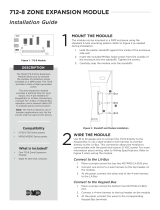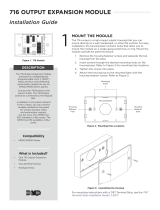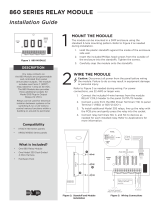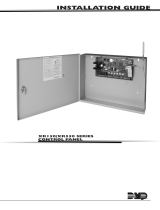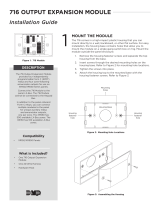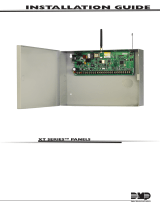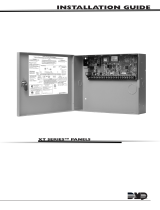Page is loading ...

INSTALLATION GUIDE
714-8/16 and 715-8/16
Zone Expanders

714-8/16 and 715-8/16 Installation Guide | Digital Monitoring Products 1
GET STARTED
The 714-8 and 714-16 provide an additional eight or sixteen supervised zones for connecting burglary and non-
powered fire alarm initiating devices to the panel.
The 715-8 and 715-16 provide an additional eight or sixteen 12 VDC ungrounded (Class B, Style A) powered zones for
connecting two-wire smoke detectors.
The zone expanders provide terminal strips, a jumper for LX-Bus or Keypad Bus designation, and a transmit data LED
to indicate panel communication.
All fire device installations must be in accordance with the manufacturer instructions, NFPA standards, and Authority
Having Jurisdiction (AHJ) requirements.
What’s Included
▶One 714-8, 714-16, 715-8, or 715-16 Zone Expander
▶Eight or sixteen 1K Ohm Resistors (714-8/714-16) or 3.3K Ohm Resistors (715-8/715-16)
▶One Model 340 or 350 Enclosure with Lock and Key
Compatibility
▶XT Series Panels and XR Series Panels
▶714-8: 1k-4.7k Ohm EOL (LevE and higher)
▶714-16: 1k Ohm EOL
▶715-8/715-16: 3.3k Ohm
INSTALLATION
1 Program the Panel
After completing each of the following steps, press CMD to advance to the next option. Refer to the panel
programming guide as needed.
1. Reset the panel and enter 6653 (PROG) at a keypad.
2. In ZONE INFORMATION, program the expansion zones as any of the panel’s burglary or fire zone types.
You can also program zones as an Arming (AR) zone type when they are being used with key switches.
3. Press CMD until STOP displays. Press a top row select key or area to save programming.
2 Mount the Enclosure
Mount the enclosure in a secure, dry place. It is not necessary to remove the zone expander circuit board when
installing the enclosure.
The enclosure can be surface or flush mounted using the holes provided. Each of the four sides have dual 1/2 in.
and 3/4 in. conduit knockouts for running wires out of the enclosure.

714-8/16 and 715-8/16 Installation Guide | Digital Monitoring Products 2
Wire the Zone Expander
The zone expanders provide a 3-pin header with jumper used to select the connection type.
To connect the expander to the Keypad Bus, place the jumper across the two leftmost pins. To connect the
expander to the LX-Bus, place the jumper across the two rightmost pins. For more information, refer to Figure 1.
Connect to the LX-Bus
To wire the 714-8/714-16, join the red, yellow, green, and black wires to a 4-wire harness and connect it to the
LX-Bus.
To wire the 715-8/715-16, connect the red wire to panel Terminal 11 (Smoke power terminal). This allows Sensor
Reset to drop power to the module and devices connected to its zones. Join the yellow, green, and black wires to
a 4-wire harness and connect it to the LX-Bus.
Connect the 714-8/714-16 to the Keypad Bus
1. Connect the red, yellow, green, and black wires to panel Terminals 7, 8, 9, and 10 respectively.
2. Observe polarity and wire the zones.
3. For 714-8 expanders with hardware Level E or higher, the expander will read any resistor from 1k-4.7k Ohms
without any additional programming. For 714-8 expanders with hardware Level D or lower and 714-16
expanders, install the included 1KOhm EOL resistors.
Connect the 715-8/715-16 to the Keypad Bus
1. Connect the red wire to panel Terminal 11 (Smoke power terminal). This allows Sensor Reset to drop power
to the module and devices connected to its zones. Alternately, connect red to a regulated, power limited
power supply listed for Fire Protective Signaling through a Model 716 relay. Use the Sensor Reset Output
programming to drop power to the expander.
2. Connect the yellow, green, and black wires to panel Terminals 8, 9, and 10 respectively.
3. Observe polarity and wire the zones.
4. Install the included 3.3K Ohm EOL resistors.
3
SPECIFICATIONS 714-8 MODULE 714-16 MODULE 715-8/715-16 MODULE
Normal Operating Range 650-2100 Ohms 650-2100 Ohms 1200-6000 Ohms
Zone Resistors 1k-4.7k Ohm EOL 1k Ohm EOL 3.3k Ohm EOL
Max Line Impendence 100 Ohms 100 Ohms 100 Ohms
Zone Ground Fault 1500 Ohms or less 1500 Ohms or less 80 Ohms or less
Zone Supervision All Zones All Zones All Zones
Table 1: Zone Expander Specifications

714-8/16 and 715-8/16 Installation Guide | Digital Monitoring Products 3
From
Keypad Bus
or LX-Bus
TXD
KYPD LX
Z13+
Z13-
Z14+
Z14-
Z15+
Z15-
Z16+
Z16-
Z9+
Z9-
Z10+
Z10-
Z11+
Z11-
Z12+
Z12-
Z5+
Z5-
Z6+
Z6-
Z7+
Z7-
Z8+
Z8-
Z1+
Z1-
Z2+
Z2-
Z3+
Z3-
Z4+
Z4-
BLK
GRN
YEL
RED
Mounting Hole
To panel
smoke detector
power circuit
To Zone Positive and Negative
Power
Supervision
Relay
3.3k EOL Model 309
2-Wire Smoke Detectors
To Zone Positive and Negative
3.3k Ω EOL Model 309
Mounting Hole
Mounting Hole Mounting Hole
+-
714-8/714-16:
Connect Red to LX-Bus Wire or Panel Terminal 7
715-8/715-16:
Connect Red to Panel Terminal 11
715-8/715-16
Smoke Wiring
KYPD LX
LX-Bus
Keypad Bus KYPD LX
0
1
2
3
4
5
6
7
8
9
S2
0
1
2
3
4
5
6
7
8
9
S1
TENS ONES
Selection Jumper
Address Switches
714-16: 1k Ω EOL
714-8: 1k-4.7k Ω EOL
715-8/715-16: 3.3k Ω EOL
0
1
2
3
4
5
6
7
8
9
0
1
2
3
4
5
6
7
8
9
TENS ONES
+
-
+
-
+
-
4
Set the Zone Expander Address
714-8/16 and 715-8/16 Point Zone Expanders use two rotary switches (TENS and ONES) to set the zone expander
address.
For keypad bus addresses, the ONES switch must be set to a starting address that communicates the status
of the first four zones (Z1 through Z4) on the expansion module. The next consecutive keypad address is
automatically used to communicate the status of the next four zones (Z5 through Z8), etc. For example, when you
set the TENS switch to 0 and the ONES switch to 2, the first four expander zones respond as zones 21 through 24.
Expander zones 5 through 8 respond as panel zones 31 through 34, zones 9 through 12 respond as panel zones 41
through 44, and zones 13 through 16 respond as panel zones 51 through 54. Refer to Table 2.
For LX-Bus addresses, set the switches to match the second two digits of the first panel zone being used. The
next 15 zone addresses communicate the status of the expander zones 2 through 16. For example, if you set the
TENS switch to 3 and the ONES switch to 2, the sixteen zones on the expander respond as panel zones 532 to
547 when connected to LX500. When connected to LX600, the zones respond as 632 to 647. Refer to Table 3.

714-8/16 and 715-8/16 Installation Guide | Digital Monitoring Products 4
KEYPAD BUS ADDRESS
SWITCHES ZONE NUMBERS
TENS ONES XT30/XT50 AND XR150 SERIES XR550 SERIES
1 0 1 11 to 14 11 to 14
2 0 2 21 to 24 21 to 24
3 0 3 31 to 34 31 to 34
4 0 4 41 to 44 41 to 44
5 0 5 51 to 54 51 to 54
6 0 6 61 to 64 61 to 64
7 0 7 71 to 74 71 to 74
8 0 8 81 to 84 81 to 84
9 0 9 N/A 91 to 94
10 1 0 N/A 101 to 104
11 1 1 N/A 111 to 114
12 1 2 N/A 121 to 124
13 1 3 N /A 131 to 134
14 1 4 N/A 141 to 144
15 1 5 N /A 151 to 154
16 1 6 N/A 161 to 164
Table 2: Keypad Bus Addresses and Corresponding Zone Numbers
SWITCH XR150/XR550 SERIES XR550 SERIES
TENS ONES LX500 ZONES LX600 ZONES LX700 ZONES LX800 ZONES LX900 ZONES
0 0 500 500 - 515 600 600 - 615 700 700 - 715 800 800 - 815 900 900 - 915
0 1 501 501 - 516 601 601 - 616 701 701 - 716 801 801 - 816 901 901 - 916
0 2 502 502 - 517 602 602 - 617 702 702 - 717 802 802 - 817 902 902 - 917
0 3 503 503 - 518 603 603 - 618 703 703 - 718 803 803 - 818 903 903 - 918
0 4 504 504 - 519 604 604 - 619 704 704 - 719 804 804 - 819 904 904 - 919
... ... ... ... ... ... ... ... ... ... ... ...
8 0 580 580 - 595 680 680 - 695 780 780 - 795 880 880 - 895 980 980 - 995
8 1 581 581 - 596 681 681 - 696 781 781 - 796 881 881 - 896 981 981 - 996
8 2 582 582 - 597 682 682 - 697 782 782 - 797 882 882 - 897 982 982 - 997
8 3 583 583 - 598 683 683 - 698 783 783 - 798 883 883 - 898 983 983 - 998
8 4 584 584 - 599 684 684 - 699 784 784 - 799 884 884 - 899 984 984 - 999
Table 3: LX-Bus and Corresponding Zone Numbers

714-8/16 and 715-8/16 Installation Guide | Digital Monitoring Products 5
ADDITIONAL INFORMATION
Wiring Specifications
DMP recommends using 18 or 22 AWG for all LX-Bus and Keypad Bus connections. The maximum wire distance
between any module and the DMP Keypad Bus or LX-Bus circuit is 1,000 feet. To increase the wiring distance, install
an auxiliary power supply, such as a DMP Model 505-12. Maximum voltage drop between a panel or auxiliary power
supply and any device is 2.0 VDC. If the voltage at any device is less than the required level, add an auxiliary power
supply at the end of the circuit.
To maintain auxiliary power integrity when using 22-gauge wire on Keypad Bus circuits, do not exceed 500 feet.
When using 18-gauge wire, do not exceed 1,000 feet. Maximum distance for any bus circuit is 2,500 feet regardless of
wire gauge. Each 2,500 foot bus circuit supports a maximum of 40 LX-Bus devices.
For additional information refer to the LX-Bus/Keypad Bus Wiring Application Note (LT-2031) and the 710 Bus
Splitter/Repeater Module Installation Guide (LT-0310).
LED Operation
The LED on the zone expanders flashes each time the zone expander responds to a poll from the panel. If there is a
problem with the hardware, panel programming, or the green data wire between the panel and the zone expander
zone expander, the LED stops flashing and System Trouble appears in the keypad display.
COMPLIANCE INFORMATION
UL Commercial Burglary
To comply with ANSI/UL 365 Police-Connected Burglary System or ANSI/UL 609 Local Burglary Alarm Systems, the
zone expander must be mounted in the supplied, UL listed enclosure with a tamper.
UL Commercial Fire
See the panel installation guide for details for selecting compatible 2-wire smoke detectors. Any auxiliary power
supply used must be regulated, power limited and listed for Fire Protective Signaling.
ULC Commercial Burglary (XR150/XR550 Series Panels)
Place the zone expander zone expander in a listed enclosure and connect a DMP Model 307 Clip-on Tamper Switch to
the enclosure programmed as a 24-hour zone.
The 714/715 zones can be installed in medium or high risk applications when two zones are used as shown in the Dual
Zone Protection diagram in the XR150/XR550 Canadian Installation Guide. Otherwise, 714/715 zones can only be used
in low risk applications.
ULC Residential Fire (XR150/XR550 Series Panels)
Refer to the appropriate panel compliance listing guide for the complete list of UL approved smoke detectors.

18205
Designed, engineered, and
manufactured in Springfield, MO
using U.S. and global components.
LT-0401 1.06 21344
INTRUSION • FIRE • ACCESS • NETWORKS
2500 North Partnership Boulevard
Springfield, Missouri 65803-8877
800.641.4282 | DMP.com
© 2023
SPECIFICATIONS
Operating Voltage 8.8 to 15.0 VDC
Operating Current
714-8/16
Average 20mA + 1.6mA per zone
Alarm 20mA + 2mA per zone
715-8/16
Average 20mA + 4mA per zone
+ 0.1 per 2-wire smoke
Alarm 20mA
+ 58mA per shorted zone
+ 0.1 per 2-wire smoke
+ 30mA per smoke in alarm
Dimensions
340 Enclosure 12.50 W x 9.50 H x 2.85 D in.
350 Enclosure 17.50 W x 13.50 H x 3.50 D in.
CERTIFICATIONS
▶California State Fire Marshal (CSFM)
Underwriters Laboratory (UL) Listed
ANSI/UL 365 Police Station Connect Burglar Alarm Systems
ANSI/UL 609 Local Burglar Alarm Units & Systems
ANSI/UL 864 Fire Protective Signaling Systems
ANSI/UL 985 Household Fire Warning System Units
ANSI/UL 1023 Household Burglar Alarm System Units
ANSI/UL 1076 Proprietary Burglar Alarm Units & Systems
ANSI/UL 1610 Central Station Burglar Alarm Units
ULC Subject-C1023 Household Burglar
ULC/ORD-C1076 Proprietary Burglar
ULC S304 Central Station Burglar
ULC S304 Household Fire
/





